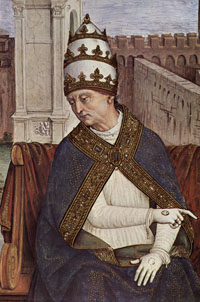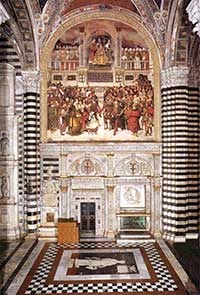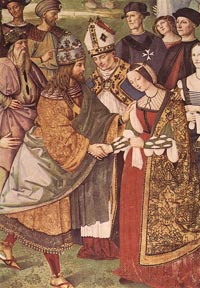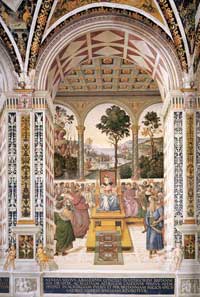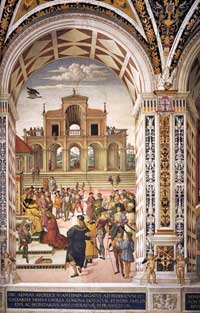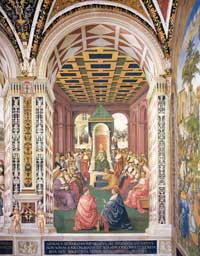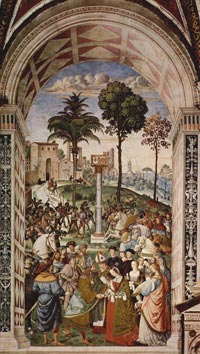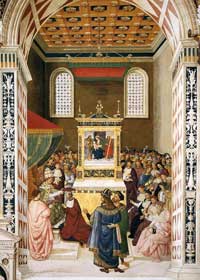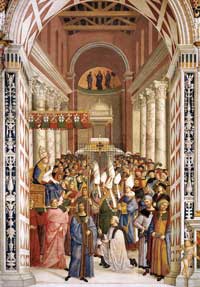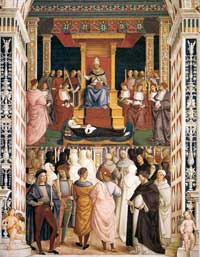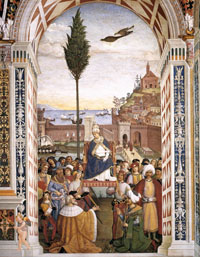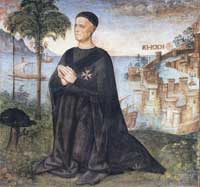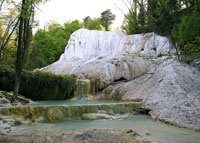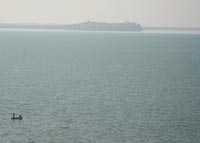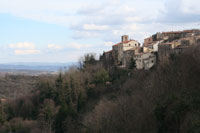 |
Pinturicchio, The Canonization of Catherine of Siena by Pope Pius II (detail), fresco in the Piccolomini Library, Duomo, Siena One of the many frescoes of Pius II located in the 'Piccolomini library' in the Duomo in Siena. |
Pinturicchio | Frescoes in the Piccolomini Library of the Duomo in Siena |
| Pinturicchio's fresco cycle in the Piccolomini Library is a rare example of a unified decoration of the early sixteenth century. Well-suited to Pinturicchio's skills and to a somewhat provincial Siena, his lyric style fits comfortably into the medieval setting of the Cathedral.[1] The subject matter concerns incidents in the life of Aeneas Silvius Piccolomini, the Sienese pope (Pius II) and humanist, an unusually complete program for someone neither a saint nor a ruler.[2] The Piccolomini Library, together with the cathedral pavement and the St Catherine Chapel in San Domenico, has always had great popular appeal. An understanding of the works should consider the enduring fame of the frescoes and ignore the often excessive enthusiasm or condemnation of past authors. The Swoon of St Catherine of Siena inspired Ingres and the Purists, who interpreted Sodoma's images of piety and mysticism with sentimental sobriety. The scenes from the Life of Pius II by Pinturicchio became a prototype of history painting for the Pre-Raphaelites and the Decadents. The decline of the Decadent movement led to a drop in art-historical appreciation of the Piccolomini frescoes, Berenson being a particular case in point. The public, however, who were greatly attached to the illustrative and celebratory character of the fresco cycle, continued to admire Pinturicchio's magnificent example of history painting. The scenes were painted in the crucial early years of the sixteenth century. The narratives are illustrated with descriptive clarity, the figures precisely drawn, the unatmospheric landscape bright and sharply defined. During this time the sweet classicism of the Umbrian school conquered Sienese painting. When Pinruricchio undertook the library commission he was nearing the end of his career and his style was under threat from the imminent emergence of artists such as Raphael. Pinturicchio illustrated the powerful Piccolomini family's desire for a nostalgic evocation of their glories. The work was completed while Pandolfo Petrucci was consolidating his power over Siena at a time when the favoured artists in Siena were Luca Signorelli, Perugino and Pinturicchio. About halfway down the nave on the left is the entrance to the Piccolomini library, famed for its precious illuminated choir books and beautifully preserved Renaissance frescoes painted by Pinturicchio, probably based on designs by Raphael. The library was commissioned by Cardinal Francesco Piccolomini, Archbishop of Siena (later Pope Pius III), to honor the memory and book collection of his maternal uncle Enea (Aeneas) Piccolomini, who became Pope Pius II. |
||
In I492 Cardinal Francesco Todeschini Piccolomini, archbishop of Siena, began constructing a hall, made out of the old cathedral canonry, to house the Greek, Latin and Hebrew codices of his maternal uncle, the great humanist pope. Pius II. Francesco's intention was to decorate the room on the model of the classically inspired Vatican Library commissioned by Sixtus IV, his knowledge of which stemmed from his long stays in Rome when he studied there assiduously. Francesco was interested in both literature and art and witnesses from within the humanist world wrote about his collection. 'He had the graces in niches', wrote Poliziano. He was referring not only to the celebrated marble group that had been seen by Albertini and was later transferred to the Piccolomini Library, but also to Cardinal Piccolomini's collection of manuscripts. The original holding had been formed by Pius II but was added to by Francesco. Cardinal Piccolomini wanted to house the collection in his native city, the place where Pius II had studied during his youth. The Piccolomini family had already played a decisive role in the urban development of Siena by constructing two palaces designed by Rossellino and situated in via di Citta and in Banchi di Sotto. The geometric facades of the Piccolomini palaces stood in contrast to the crooked medieval streets. The magistracy in charge of coordinating building within Siena described them as 'marvelous work' and a 'very dignified ornamentation' of the city. Now Francesco wanted to add a library to these palaces, which were public only in so far as their imposing facades looked out on to the street. The proposed library was intended to celebrate the Piccolomini family. Francesco did not turn to Sienese masters, limiting their contribution to the carpenter Antonio Barili who, between 1495 and 1496, produced the furniture in which to keep the manuscripts. At around this time plans were made for the vault, which was to be decorated with leaf patterns. However, this remained a provisional solution because on 29 June 1502 the' Cardinale di Siena' signed a contract with Bernardino detto el Pelltllricchio pictore Perusino' (Bernardino, called Pinturicchio, a painter from Perugia) for the fresco decoration of the room. Piccolomini chose one of Perugino's pupils who had already been employed in the greatest houses in Italy. Pinturicchio had painted a chapel 'barely touched by the new fashion for grotesque decorations' in Santa Maria in Aracoeli in Rome for the Bufalini in c. 1485. He had also worked in the Borgia apartments in the Vatican between 1492 and 1494, which contained decorations overflowing with classical The pictures show the entrance to the Piccolomini Library in the left aisle of the cathedral in Siena, and the fresco The Coronation of Pope Pius III. This monumental fresco above the richly carved classical façade depicts the coronation of the library's donor, Francesco Todeschini-Piccolomini, as Pope Pius III. In the lunette above the portal the donor's coat of arms as cardinal, in the right-hand lunette the papal coat of arms of his uncle Pius II can be seen. The fresco The Coronation of Pope Pius III is on the entrance wall to the Piccolomini Library in the left aisle of the cathedral in Siena. It records an event that took place on October 8, 1503 in front of the old St Peter's. The painter must have executed this work at the behest of the heirs, for the new pope died a mere ten days after the event depicted. The fresco was heavily overpainted in the sixteenth and nineteenth centuries, and it was restored in the 1960s. Pinturicchio painted this cycle of frescoes around the library between 1502 and 1507, representing Rafael and himself in several of them. This masterpiece is full of striking detail and vivacious colours. Each scene is explained in Latin by the text below. They depict ten remarkable events from the secular and religious career of pope Pius II. Each scene is labeled with a Latin inscription, taken from the pope's biography by the humanist writer Giovanni Antonio Campano. The story begins at the end of the room next to the right-hand window, then proceeds clockwise around the room. The scenes depicted are as follows: |
iccolomini Library, Duomo, Siena |
|
Pinturicchio's fresco cycle is a rare example of a unified decoration of the early sixteenth century. Well-suited to Pinturicchio's skills and to a somewhat provincial Siena, his lyric style fits comfortably into the medieval setting of the Cathedral. |
||
| The cycle's first three scenes, beginning with the one on the right wall closest to the windows, represent the initial phase of Enea Silvio Piccolomini's secular career.
In the first compartment we see the twenty-seven-year-old Enea Silvio setting out in the train of Cardinal Domenico Capranica for the Council of Basel in 1431. Wearing a splendid traveling cloak, a fur collar, and a pilgrim's hat, the young man sits on a white horse - an obvious allusion to his future stature, for white horses were reserved for popes. |
||
| 1 Enea Piccolomini Leaves for the Council of Basle |
||
| In the first compartment we see the twenty-seven-year-old Enea Silvio setting out in the train of Cardinal Domenico Capranica for the Council of Basel in 1431. Wearing a splendid traveling cloak, a fur collar, and a pilgrim's hat, the young man sits on a white horse - an obvious allusion to his future stature, for white horses were reserved for popes. The humanist Aeneas Sylvius Piccolomini spent his later life, including his pontificate as Pope Pius II (1458–1464), explaining away the errors of his youth. He had, as a young cleric, adhered to the Council of Basel (1431–1449) and its antipope, Felix V. Aeneas self-consciously changed his interpretation of Felix, the former Duke Amadeus VIII of Savoy, from favorable to unfavorable. Even his physical description of the antipope became negative. Nonetheless, he was careful to place the worst criticism of Felix into the mouths of others, further distancing himself from his past. Piccolomini’s nephew, Francesco Todeschini Piccolomini, had Felix excluded from the pictures narrating his uncle’s life he had Pinturicchio execute for the Piccolomini Library in Siena. |
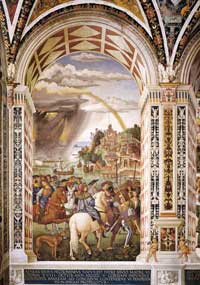 Pinturicchio, Enea Piccolomini Leaves for the Council of Basle, fresco in the Piccolomini Library, Duomo, Siena |
|
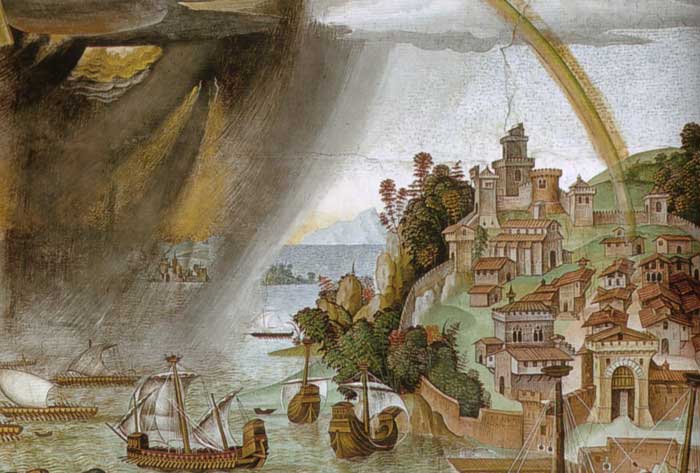 |
||
Pinturicchio, Enea Piccolomini Leaves for the Council of Basle (detail), fresco in the Piccolomini Library, Duomo, Siena |
||
| 2 Enea Piccolomini as an Ambassador to the Court of James I of Scotland |
||
| The second scene is set at the court of the Scottish king in 1435. While in Basel, Enea Silvio was employed as a secretary by cardinal Albergati, who immediately dispatched him to the court of James I of Scotland. His job was to try to enlist the king as an ally against England, and at this he was unsuccessful. We see the ambassador in a long red cloak on the left, standing in front of the throne and gesturing in the typical pose of debate. |
||
| 3 Frederick III Crowning Enea Silvio Piccolomini with a Laurel Wreath |
||
| The third scene reminds us of the young Enea Silvio's literary triumphs. In Frankfurt Frederick III had convened his first diet after having been crowned king of Germany. On July 27, 1442 Frederick himself crowned Piccolomini with a laurel wreath, presumably for the request of Enea Silvio. The emperor places the wreath on the poet's head in front of an especially ornate and theatrical architectural prospect. The many figures on the pink-paved square are clustered in casual groupings. |
||
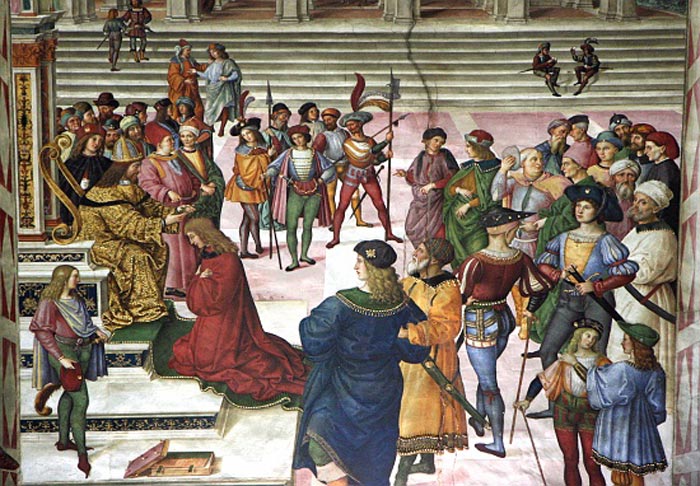 |
||
Aeneas Piccolomini is crowned poet laureate by Holy Roman Emperor Frederick III in 1442, fresco by Pinturicchio, Piccolomini Library, Duomo, Siena |
||
| 4 Homage to Pope Eugenius IV in the Name of Emperor Frederick III |
||
| There is a distinct break in the narrative before the fourth scene. In 1445 Piccolomini suffered a major spiritual crisis, and he turned away from his secular way of life. He became interested in effecting some kind of compromise between the emperor and the pope. Frederick III sent him to the papal court to urge Eugenius IV to convene a new council, and Piccolomini took that opportunity to beg the pope to forgive him for having strayed from the faith. The pope is seated on an elevated throne, flanked by cardinals. Enea Silvio, dressed in a splendid gold robe, has thrown himself at his feet. In the background in the portico on the left, there is an additional scene: the rueful Enea Silvio is consecrated as a priest. |
||
| 5 Enea Silvio Piccolomini Presents Frederick III to Eleonora of Portugal |
||
In 1450 Aeneas was sent as ambassador by the Emperor Frederick III to negotiate his marriage with the princess Eleonore of Portugal, which object he successfully achieved. |
|
|
| 6 Enea Silvio is Elevated to Cardinal |
||
| The narrow north wall of the library contains two scenes, the fifth and the sixth of the cycle. The sixth scene shows Pope Calixtus III Borgia anointing Enea Silvio a cardinal on December 17, 1456. In that same ceremony the pope's nephew, Rodrigo Borgia - the later Pope Alexander VI - was elevated to the same dignity. The focus of the scene is the altar retable, a painting of the Madonna with Saints James and Andrew, the patron saints of the Piccolomini. |
||
| 7 The Coronation of Enea Silvio Piccolomini as Pope Pius II |
||
| The seventh scene is on the first compartment of the east wall. Here we are presented with the major event in Enea Silvio's life, his coronation as Pius II on September 3, 1458. The picture shows the ceremony in St. Peter's, confirmed by the apse mosaic showing Christ standing between Peter and Paul. At the death of Pope Calixtus III in 1458, the cardinals chose a man who for his diplomatic skills seemed able to effectively promote the crusade against the Ottomans. Cardinal Enea Silvio Piccolomini became a priest at the age of 42, after having served as a secretary and an ambassador for both the pope and the German emperor. He had a vast knowledge of the classic world and a high level of self-esteem, which he showed in choosing the name of Pius (II), because this adjective (Engl. pious) was associated with his own name (Enea) in Virgil's Aeneid: Aeneas then unsheath'd his shining sword, And thus with pious pray'rs the gods ador'd (Virgil, Aeneid, Book 12). |
||
| 8 Pope Pius II at the Congress of Mantua |
||
The eighth scene depicts the Congress of Mantua which was convened by Pius II on June 26, 1459. There the pope sought to enlist the princes of Europe in a new crusade specifically against the Turks, who had conquered Constantinople in 1453. |
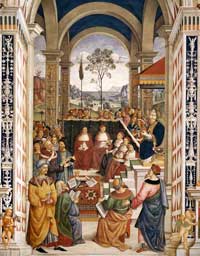 Pinturicchio, Pope Pius II at the Congress of Mantua, fresco in the Piccolomini Library, Duomo, Siena |
|
| 9 The Canonization of Catherine of Siena by Pope Pius II |
||
| The ninth scene focuses on the canonization of Catherine of Siena in St. Peter's on June 29, 1461. It was the high point of Pius II's spiritual career. The occasion was a triumph for the Sienese, for they could now boast of a local female saint in addition to the popular Bernardino, who had been declared a saint only in 1450. Raphael created original design drawings for this project despite the fact that he was employed by an artist thirty years his senior who had been commissioned to carry out the work. Just as in this case, when Raphael became too busy to attend to every detail of his production himself he did not reserve the design process to himself. |
||
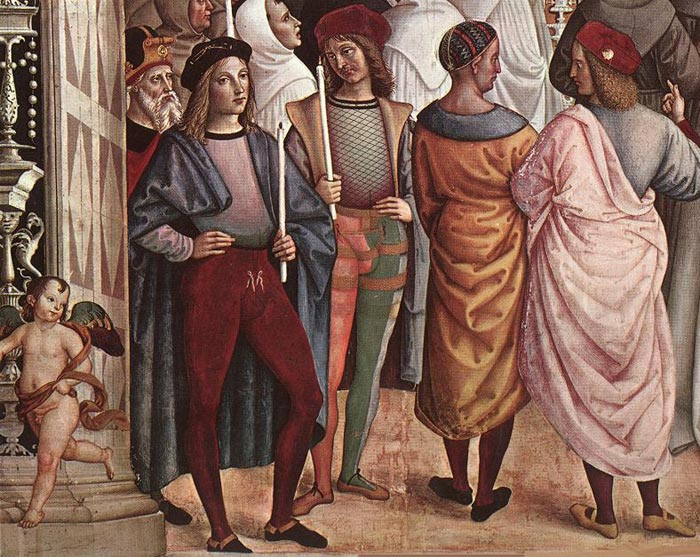 |
||
Pope Aeneas Piccolomini Canonizes Catherine of Siena (detail), with on the left presumed portraits of Rafael and Pinturicchio
Piccolomini Library, Duomo, Siena
|
||
| 10 Pope Pius II Arrives in Ancona |
||
| The tenth and last picture in the cycle is set in the Adriatic port of Ancona, a view of which takes up the right side of the background. On July 19, 1464 the ailing pope arrived in Ancona, where he was to await the Venetian fleet that would lead his crusade. he died there a week later. After his death the unpopular crusade was called off. |
|
|
The floor |
||
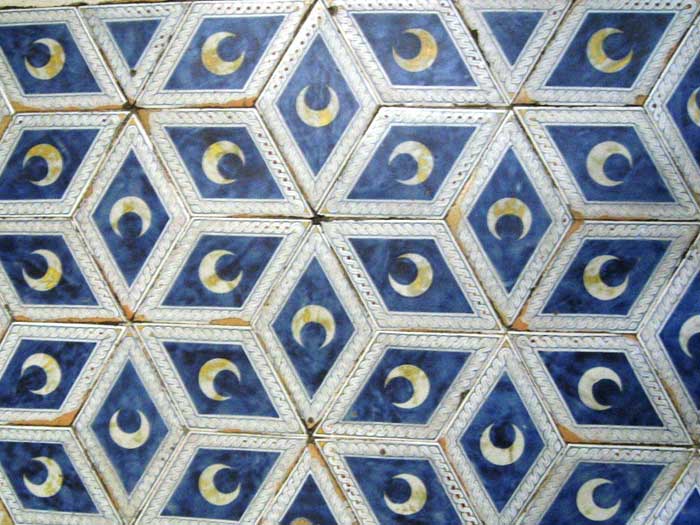 |
||
Pinturicchio, ceramic floor of the Piccolomini Library (detail), Duomo, Siena
|
||
| The ceramic floor is decorated with half moons on a blue background – the emblem of the Piccolomini family. The murals of the Piccolomini Library, featuring episodes from the life of Pope Pius II, are usually discussed as distinctly separate from the vault imagery, predominantly all'antica and mythological scenes. The latter, combined with the centrally-placed, antique statue of The Three Graces, has led some authors to comment on the library's overtly 'pagan' content as shockingly incongruent with its setting in the sacred precincts of the duomo. Little attention is paid to the significance of the stucco relief above the entrance, The Expulsion from Paradise. The article pro-poses that such a prestigious project for so powerful and erudite a patron as Cardinal Francesco Todeschini Piccolomini, and painted by the highly acclaimed artist Pinturicchio, is unlikely to have been devised without careful attention to its iconographical programme. Focussing primarily on the two largest compartments of the vault, it is demonstrated that the four principal figures there should be interpreted as representatives of the four temperaments. By defining their relationship as such to the Expulsion from Paradise relief and to the historical narratives on the walls, this article shows that the mythological scenes in the vault play an allegorical role within the broader scheme and that a coherent programme underpins the entire decoration, with the writings of Saint Augustine and of his fifteenth century followers at its core. |
||
In the period 1504-06 Pinturicchio accepted some smaller commissions in Siena, in addition to working in the Piccolomini Library. Among these commissions he painted scenes from the life of St John the Baptist in the Chapel of St John in the cathedral. Here he depicted the portrait of the donor, Alberto Aringhieri, in the habit of a knight of Malta.
|
||
Picture Gallery Piccolomini library
|
||||
 |
 |
 |
||
Portale della Libreria Piccolomini del Marrina, Siena Duomo
|
Libreria Piccolomini, affrescata da Pinturicchio
|
Libreria Piccolomini, Siena, Duomo. La Cacciata dal Paradiso Terrestre
|
||
 |
 |
 |
||
Incoronazione di Pio III, pure di Pinturicchio (1503-1508)
|
Le tre grazie, Libreria Piccolomini, Siena Duomo | Marrina (attr.), cacciata dal paradiso terrestre (da Jacopo della Quercia)
|
||
|
||||
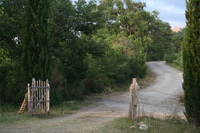 |
||||
The brisk autumn air, the nature that is colored and the delicacies of our hills... |
|
|||
Bagni San Filippo |
Lago Trasimeno |
Scansano |
||
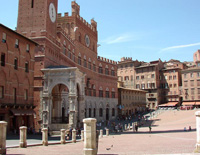 |
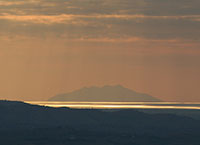 |
|||
Siena, duomo |
Siena, Palazzo Publicco |
Sunsets in Tuscany |
||
 |
||||
Although this is off the beaten track it is the ideal choice for those seeking a peaceful, uncontaminated environment. |
||||
Pinturicchio |
||||
|
||||
Siena | Duomo di Siena Piazza del Duomo is dominated by the imposing structure of Siena’s cathedral, dedicated to Santa Maria Assunta. The building stands over an existing church that in turn was built over a pagan temple dedicated to the goddess Minerva. Construction of the existing Duomo started in 1200, with the main sections already completed by 1215. The dome was built between 1259 and 1264.
|
||||
| This article incorporates text from Wikipedia and from the Encyclopædia Britannica, Eleventh Edition, a publication now in the public domain, and WikiCommons Cathedral (Siena) - Piccolomini Library (71 F) | ||||

